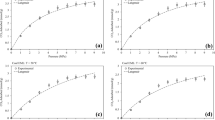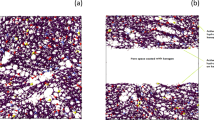Abstract
The increased urge to protect the environment from the harsh impact of CO2 emissions has led to the development of a new technology named CCS abbreviated as carbon capture and storage. CCS is a crucial technology that focuses on emission removal from the source or directly from the air. CCS is a three-step process including carbon capture, transportation, and storage with CO2 storage (CO2) as an important step as it permanently removes the CO2 from the atmosphere. CO2 can be stored in geological formations like shale, coal, and basalts with shale displaying high adsorption capacity towards CO2 gas making it a suitable site for CO2 storage. Shale is a fine-grained rock having high porosity that follows an adsorption mechanism for CO2 storage, and thus, it becomes crucially important to describe the adsorption process in shale rock. The adsorption mechanism can be studied by numerous isotherm models namely monolayer adsorption-based Langmuir, classical statistical mechanics-based Freundlich, Temkin, and micro-pore filling adsorption D-R isotherm models. This article applies isotherm models on the alum shale collected from Denmark for gases CO2, N2, and CH4 at temperatures of 195 K, 77 K, and 112 K at a depth of 9 m and predicts the best-fit isotherm model for the alum shale based on a linear regression method. The study finds that the Langmuir isotherm model was suitable for CH4 and N2 gas with accuracy of 96.86% and 95.79% and the Freundlich model of isotherm was best suitable for CO2 gas with an accuracy of 99.45%. Langmuir isotherm best describes the adsorption based on the gas–solid phase and is utilized for quantifying the adsorptive capacity of different adsorbents.




Similar content being viewed by others
Data availability
The data used in the article has been cited in the manuscript. No new data has been used.
References
Ajayi T, Gomes JS, Bera A (2019) A review of CO2 storage in geological formations emphasizing modeling, monitoring and capacity estimation approaches. 16(5). China University of Petroleum (Beijing). https://doi.org/10.1007/s12182-019-0340-8
Ali M, Jha NK, Pal N, Keshavarz A, Hoteit H, Sarmadivaleh M (2022) Recent advances in carbon dioxide geological storage, experimental procedures, influencing parameters, and future outlook. Earth Sci Rev 225. Elsevier B.V. https://doi.org/10.1016/j.earscirev.2021.103895
Ayawei N, Ebelegi AN, Wankasi D (2017) Modelling and interpretation of adsorption isotherms. J Chem 2017:1–11. https://doi.org/10.1155/2017/3039817
Bachu S (2010) Screening and selection criteria, and characterisation techniques for the geological sequestration of carbon dioxide (CO2), vol. 2. Woodhead Publishing Limited. https://doi.org/10.1533/9781845699581.1.27
Blunt M (2010) Carbon dioxide storage
Buckner CA et al (2016) We are IntechOpen, the world’s leading publisher of open access books built by scientists, for scientists TOP 1 %. Intech 11(tourism):13. [Online]. Available: https://www.intechopen.com/books/advanced-biometric-technologies/liveness-detection-in-biometrics. Accessed 12 Feb 2023
Chen X (2015) Modeling of experimental adsorption isotherm data. Information (Switzerland) 6(1):14–22. https://doi.org/10.3390/info6010014
Chen S, Gong Z, Li X, Wang H, Wang Y, Zhang Y (2021) Pore structure and heterogeneity of shale gas reservoirs and its effect on gas storage capacity in the Qiongzhusi Formation. Geosci Front 12(6). https://doi.org/10.1016/j.gsf.2021.101244
Chu KH (2021) Revisiting the Temkin isotherm: dimensional inconsistency and approximate forms. Ind Eng Chem Res 60(35):13140–13147. https://doi.org/10.1021/acs.iecr.1c01788
Daryasafar A, Shahbazi K, Ghadiri M, Marjani A (2020) Simultaneous geological CO2 sequestration and gas production from shale gas reservoirs: brief review on technology, feasibility, and numerical modeling. Energy Sour Part A: Recov Util Environ Effects 00(00):1–18. https://doi.org/10.1080/15567036.2020.1830202
Fakher S, Imqam A (2020) A review of carbon dioxide adsorption to unconventional shale rocks methodology, measurement, and calculation. SN Appl Sci 2(1). Springer Nature. https://doi.org/10.1007/s42452-019-1810-8
Gautier D, Schovsbo N (2014) Resource potential of the alum shale in Denmark. In: Proceedings of the 2nd Unconventional Resources Technology Conference. American Association of Petroleum Geologists, Tulsa. https://doi.org/10.15530/urtec-2014-1931754
Herzog HJ, Vukmirovic N (1998) Co 2 sequestration: opportunities and challenges. Am Inst Chem Eng x:1–20
Hu K, Herdegen V, Mischo H (2022) Carbon dioxide adsorption to 40 MPa on extracted shale from Sichuan Basin, southwestern China. Fuel 318, https://doi.org/10.1016/j.fuel.2022.123666
Hutson ND, Yang RT (n.d.) Theoretical basis for the Dubinin-Radushkevitch (D-R) adsorption isotherm equation
IPCC (2021) Climate change 2021: the physical science basis. In: Masson-Delmotte V, Zhai P, Pirani A, Connors SL, Péan C, Berger S, Caud N, Chen Y, Goldfarb L, Gomis MI, Huang M, Leitzell K, Lonnoy E, Matthews JBR, Maycock TK, Waterfield T, Yelekçi O, Yu R, Zhou B (eds) Contribution of Working Group I to the Sixth Assessment Report of the Intergovernmental Panel on Climate Change. Cambridge University Press, Cambridge, 2391 pp. https://doi.org/10.1017/9781009157896
Khosrokhavar R, Griffiths S, Wolf KH (2014) Shale gas formations and their potential for carbon storage: opportunities and outlook. Environ Process 1(4). Springer Basel, pp. 595–611. https://doi.org/10.1007/s40710-014-0036-4
Kumar H, Mishra MK, Mishra S (2019) Sorption capacity of Indian coal and its variation with rank parameters. J Pet Explor Prod Technol 9(3):2175–2184. https://doi.org/10.1007/s13202-019-0621-1
Kumar Singh R, Priyadarshini Nayak N (2023a) Opportunities and challenges of nanotechnology in enhanced oil recovery: an overview. Mater Today Proc. https://doi.org/10.1016/j.matpr.2023.04.392
Kumar Singh R, Priyadarshini Nayak N (2023b) Complications in drilling operations in basalt for CO2 sequestration: an overview. Mater Today Proc. https://doi.org/10.1016/j.matpr.2023.04.441
Lecomte A, Cathelineau M, Michels R, Peiffert C, Brouand M, Ura MB (2017) Uranium mineralization in the Alum Shale Formation (Sweden): evolution of a U-rich marine black shale from sedimentation to metamorphism. Ore Geol Rev 88:71–98. https://doi.org/10.1016/j.oregeorev.2017.04.021ï
Malyan A, Chaturvedi V (2021) Carbon Capture, Utilisation, and Storage (CCUS) in India from a cameo to supporting role in the nation’s low-carbon story centre for energy finance. no. Iea, pp. 1–16
Merey S, Sinayuc C (2016) Analysis of carbon dioxide sequestration in shale gas reservoirs by using experimental adsorption data and adsorption models. J Nat Gas Sci Eng 36:1087–1105. https://doi.org/10.1016/j.jngse.2016.02.052
MozaffariMajd M, Kordzadeh-Kermani V, Ghalandari V, Askari A, Sillanpää M (2022) Adsorption isotherm models: a comprehensive and systematic review (2010–2020). Sci Total Environ 812:151334. https://doi.org/10.1016/j.scitotenv.2021.151334
Nielsen LH, Johannessen PN (2009) Facies architecture and depositional processes of the Holocene–recent accretionary forced regressive Skagen spit system, Denmark. Sedimentology 56(4):935–968. https://doi.org/10.1111/j.1365-3091.2008.01007.x
Nxokwana NS (2020) Physico-chemical properties of South African shales and siltstones in the context of geological CO 2 storage
Patidar AK, Singh RK, Choudhury T (2023) The prominence of carbon capture, utilization and storage technique, a special consideration on India. Gas Sci Eng 115:204999. https://doi.org/10.1016/j.jgsce.2023.204999
Patiha, Heraldy E, Hidayat Y, Firdaus M (2016) The langmuir isotherm adsorption equation: The monolayer approach. In: IOP conference series: materials science and engineering. Institute of Physics Publishing. https://doi.org/10.1088/1757-899X/107/1/012067
Rexer TF, Mathia EJ, Aplin AC, Thomas KM (2020) Supercritical methane adsorption and storage in pores in shales and isolated kerogens. SN Appl Sci 2(4). https://doi.org/10.1007/s42452-020-2517-6
Rodosta TD, Litynski JT, Plasynski SI, Hickman S, Frailey S, Myer L (2011) U.S. Department of Energy’s site screening, site selection, and initial characterization for storage of CO2 in deep geological formations. Energy Procedia 4:4664–4671. https://doi.org/10.1016/j.egypro.2011.02.427
Schaef HT et al (2014) CO2 utilization and storage in shale gas reservoirs: experimental results and economic impacts. In: Energy Procedia. Elsevier Ltd, pp. 7844–7851. https://doi.org/10.1016/j.egypro.2014.11.819
Thickpenny A (1984) The sedimentology of the Swedish Alum Shales. Geol Soc Lond Spec Publ 15(1):511–525. https://doi.org/10.1144/GSL.SP.1984.015.01.33
Vigdorowitsch M, Pchelintsev A, Tsygankova L, Tanygina E (2021) Freundlich isotherm: an adsorption model complete framework. Appl Sci (Switzerland) 11(17). MDPI. https://doi.org/10.3390/app11178078
Wang X, Zhang F, Li L, Zhang H, Deng S (2021) Carbon dioxide capture. 58. https://doi.org/10.1016/bs.ache.2021.10.005
Xu Z, Shi W, Zhai G, Peng N, Zhang C (2020) Study on the characterization of pore structure and main controlling factors of pore development in gas shale. J Nat Gas Geosci 5(5):255–271. https://doi.org/10.1016/j.jnggs.2020.09.003
Xu T, Sciences E, Berkeley L (2009) CO 2 geological sequestration. Computer (Long Beach Calif)
Acknowledgements
Authors gratefully acknowledge the University of Petroleum &, Energy Studies (UPES), Dehradun.
Author information
Authors and Affiliations
Contributions
All authors equally contributed to the preparation of this review paper.
Corresponding author
Ethics declarations
No specific grant was given to this research by funding organizations in the private or public sectors.
Conflict of interest
The authors declare no competing interests.
Additional information
Responsible Editor: Santanu Banerjee
Rights and permissions
Springer Nature or its licensor (e.g. a society or other partner) holds exclusive rights to this article under a publishing agreement with the author(s) or other rightsholder(s); author self-archiving of the accepted manuscript version of this article is solely governed by the terms of such publishing agreement and applicable law.
About this article
Cite this article
Hazarika, S., Singh, R.K. Prediction of isotherm model for alum shale, Denmark by statistical modelling-case study. Arab J Geosci 16, 652 (2023). https://doi.org/10.1007/s12517-023-11776-5
Received:
Accepted:
Published:
DOI: https://doi.org/10.1007/s12517-023-11776-5




